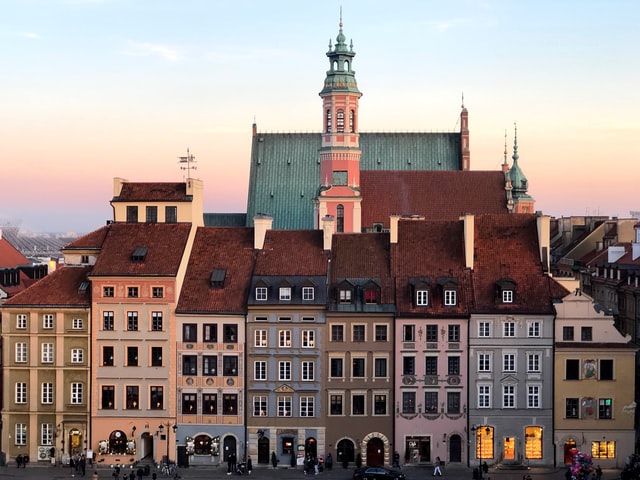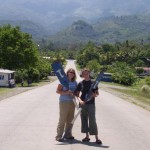Polish Milk Bars: A Taste of Grandma’s Kitchen

I was raised Polish-American in New York City, and every year my dad and I take a trip back to his hometown, in Warsaw, Poland. We would go to visit our family and friends. Discovering Polish culture has been a lifelong exploration for me that spans over many trips with my family. Visiting Warsaw this May, I got an unexpectedly delicious view of Poland’s Communist history through lunch at milk bars.
When my cousin Agata told me she was going to take me to a milk bar, I wasn’t entirely sure what to expect. The name evoked images of barstools, milk on tap, and hopefully a selection of chocolate beverages. Strange, I said, but I’d give it a try.
Our journey started with a bus ride across the Vistula River, to the Praga district. Agata hadn’t mentioned we were going there and now I knew why; Praga was well known for being the most dangerous neighborhood in Warsaw, and my apprehensive Aunt Krysia would not have allowed us to go there on our own. But as we rode past lively storefronts and tired-looking brick buildings, Agata told me how she treasured Praga for its history.
After the brutal bombings of World War II, it was one of the few areas that survived. Still, I wondered what Polish milk bars had to do with all this.
Much like the décor, milk bar fare is neither showy nor complex, but has the warmth and sturdiness of a meal from grandma’s kitchen
When we arrived, I noticed the metallic sounds of a busy kitchen. There was an orderly line of people waiting at the counter. The heavenly smell of Polish dill was my cue that we were not going to be drinking milk. This was a cafeteria! My cousin smiled at the recognition on my face, as I realized we were in one of Warsaw’s historic Communist canteens.
Milk bars in Warsaw were popular during the Communist era, when these government-subsidized cafeterias provided low-earning workers the opportunity to enjoy a meal out. Looking around, I could see evidence of the milk bar’s Communist origins: the metal-framed chairs and tables, the wood-paneled walls, the faded red curtains that hung parted in the front window. There was not a single decorative aspect. Only a slender vase in the center of each table containing a tiny fresh tulip.
My eyes landed on a handwritten menu on the wall. Although my Polish was not fluent, I had always been proficient in food vocabulary. They were, in fact, the most interesting and important words as far as I was concerned. I eagerly read through the lists of Polish dishes: soup, pierogis, salad.
As the name would suggest, milk bar canteens traditionally offered dishes that centered on milk instead of meat, due to meat rations during tough times. Nowadays, milk bars serve meat dishes, and I delighted in seeing some of my favorite foods listed on the menu: golabki (stuffed cabbage), golonka (pork ankle), and zrazy (rolled beef).
In a city where many cultural relics were destroyed by war, it is important to recognize the surviving artifacts of Poland’s past, even if they are a little off the beaten path.
I followed Agata’s lead as she lined up to order from the stern-looking bespectacled Babcia (grandmother), who was sitting at a desk with a cash box. I ordered zupa grzybowa (mushroom soup), and pierogi z serem (Polish dumplings filled with cheese) with surówka z marchewki (carrot and apple salad). The cashier counted my zloty (Polish currency). She then gestured for me to claim my meal at the counter. To my delight, the government maintains the tradition of paying a portion of the bill, so my two-course meal came to about $3!
Much like the décor, milk bar fare is neither showy nor complex. It has the warmth and sturdiness of a meal from grandma’s kitchen (if you happen to have a Polish babcia). Agata and I enjoyed our steaming hot pierogi, and crisp salads. At the end of the meal, she surprised me with an order of paczki, glazed donuts filled with raspberry jam.
Polish milk bars are not fancy. They are certainly not considered fine dining. You won’t find tourists at a milk bar. In fact, my aunt would be scandalized if she knew that Agata had taken their American guest out to lunch there. But, I suppose that’s what makes the experience so authentically Polish. Milk bars cater to locals. I had an opportunity to see a bit of history that Warsaw does so well to preserve. And it was without editing for tourist consumption.
In a city where many cultural relics were destroyed by war, it is important to recognize the surviving artifacts of Poland’s past. Even if they are a little off the beaten path. These types of experiences get me a little closer to understanding Poland.
Polish Milk Bars: A Taste of Grandma’s Kitchen
You can find milk bars all over the city of Warsaw, and other Polish cities as well. After the delicious meal with my cousin, I went on a search to find the ones I liked best. Many pierogi later, the winner is Rusalka, located at Florianska 14, 03-001 Warszawa, Poland.
Photo credit (top)Polish Milk Bars: A Taste of Grandma’s Kitchen: unsplash.com Where’s your favorite milk bar?








